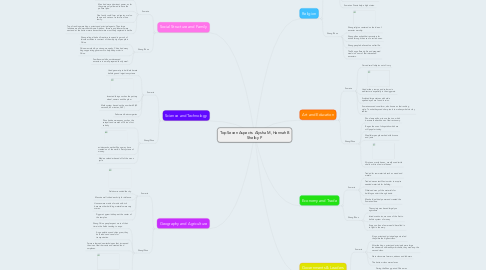
1. Religion
1.1. Sumeria
1.1.1. Practiced Polytheism, the worship of many gods.
1.1.2. Believed that gods controlled all natural forces.
1.1.3. Believed they protected each city-state and were like humans in many ways.
1.1.4. Sumerian Priests help a high status.
1.2. Shang/Zhou
1.2.1. Shang religion centered on the idea of ancestor worship.
1.2.2. Shang often asked their ancestors for advice through the use of oracle bones.
1.2.3. Shang people believed in an afterlife.
1.2.4. The Shang offered gifts and prepared meals in honor of their deceased ancestors.
2. Art and Education
2.1. Sumeria
2.1.1. Carved small objects out of ivory
2.1.2. Used arches, ramps and columns in architecture especially in the ziggurats.
2.1.3. Sculpted large statues with wide opened eyes are found in ruins.
2.1.4. Sumerians used cuneiform, also known as their writing style. To write they used sharp tools to make symbols in clay tables.
2.2. Shang/Zhou
2.2.1. Zhou learned how to use the iron, which became the backbone of their economy.
2.2.2. Began the use of chopsticks which are still popular today.
2.2.3. Wealthier people worked with bronze and jade
2.2.4. Wrote on oracle bones, usually used turtle shells or bits of animal bones.
3. Economy and Trade
3.1. Sumeria
3.1.1. Traded for raw materials such as wood and metals.
3.1.2. Traded woven textililes in order to acquire needed materials for building.
3.1.3. Obtained many of the materials for buildings and art through trade.
3.1.4. Men held political power and created the Sumerian laws.
3.2. Shang/Zhou
3.2.1. The society was based largely on agriculture
3.2.2. Introduced coins, was one of the first to build a system of money
3.2.3. Every so often a famer would be called in to fight in the army.
4. Social Structure and Family
4.1. Sumeria
4.1.1. Women did most of the work at home, taking care of the children and preparing food.
4.1.2. Men had more dominant power, as for they were only allowed to have the political jobs.
4.1.3. One family could form a dynasty, or also known as a series of rulers from one family.
4.1.4. Top of ranking were kings, priests and principal agents. Then large landowners and merchant owners. Artisans, farmers and laborers were next and at the bottom were slaves that were most likely captured in battle
4.2. Shang/Zhou
4.2.1. Shang ruling elite had free time to spend in pursuit of leisure activities in contrast of the majority of people in China
4.2.2. China was ruled by a strong monarchy, China had many kings appointing governors to help keep order in China.
4.2.3. Families would honor deceased ancestors in a well prepared family meal.
5. Science and Technology
5.1. Sumeria
5.1.1. Used geometry to build elaborate buildings and irrigation systems
5.1.2. Invented things such as the pottery wheel, sewers and the plow.
5.1.3. Math system based on the number 60 (60 seconds, 60 minutes, 360`)
5.1.4. Performed basic surgeries
5.2. Shang/Zhou
5.2.1. Zhou had new weapons such as the catapult and creates of China's first calvalry
5.2.2. evidence shows that Shang may have created on of the world's first systems of money.
5.2.3. Made a calender based off of the moon cycle
6. Governments & Leaders
6.1. Sumeria
6.1.1. Kings, priest and principal agents ruled they were the highest class.
6.1.2. After the kings, priest and principals were large landowners and wealthy merchants, they made up the second class.
6.1.3. Next class were farmers, artisans and laborers
6.1.4. The bottom class were slaves
6.2. Shang/Zhou
6.2.1. During the Shang period China was ruled by a strong monarchy
6.2.2. Sahng king were surrounded by a court in capital
6.2.3. Shang was overthrown because theyhad lost god's favor
6.2.4. Zhou conquered Shang and introduced the idea that they were ruled by Mandate of Heaven
7. Geography and Agriculture
7.1. Sumeria
7.1.1. Fields surrounded the city.
7.1.2. Massive wall circled each city for defense.
7.1.3. Houses were made of mud and brick because other building materials were very scares.
7.1.4. Ziggurat: pyramid shape at the center of the temples.
7.2. Shang/Zhou
7.2.1. Shang China people spent most of their time in the fields tending to crops.
7.2.2. As populations and cities grew, they built roads and canals for transportation.
7.2.3. Farmers learned new techniques that increased the size of their harvests and created food surpluses.
7.2.4. Lived near river valleys covered in fertile soils allowing them to be an agriculture based society.
